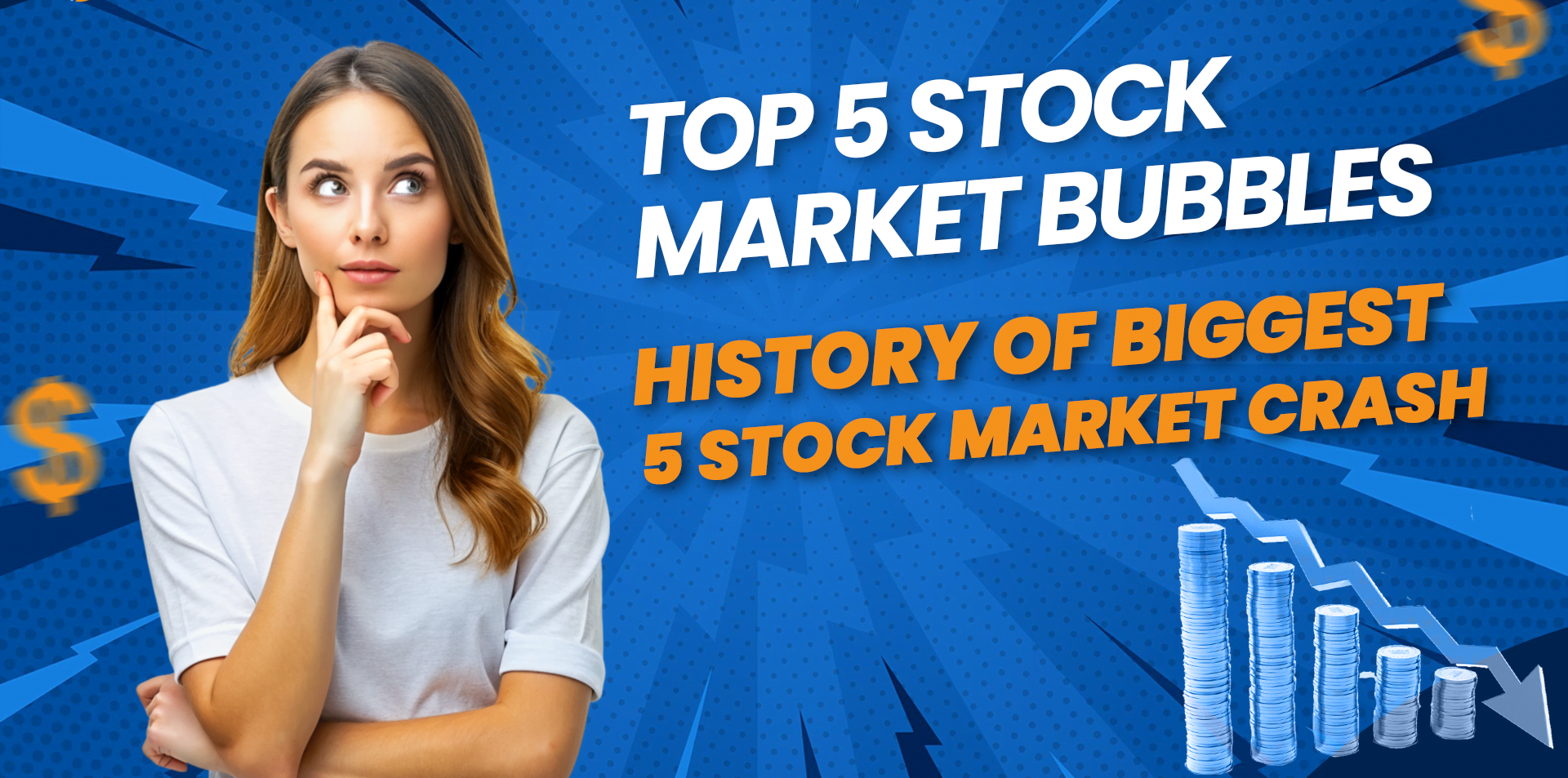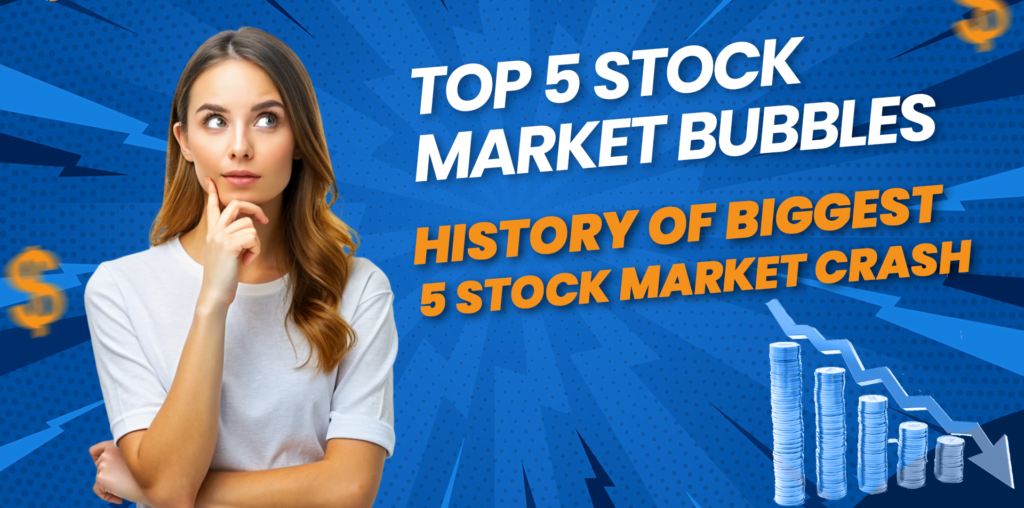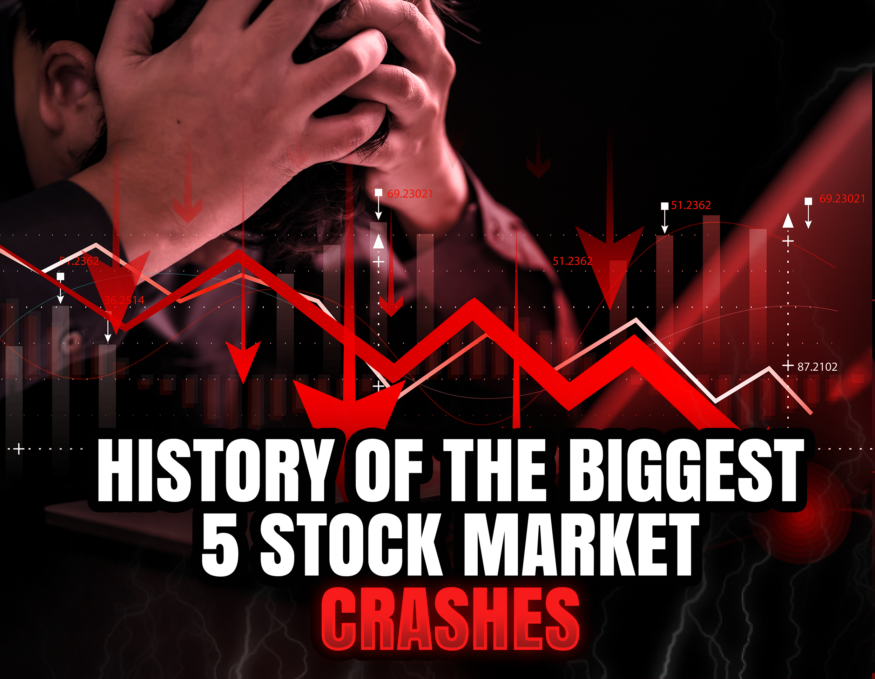Top 5 Stock Market Bubbles | History of Biggest 5 Stock Market Crash


Top 5 Stock Market Bubbles : In the world of investing, stock market bubbles are notorious for inflating rapidly and bursting even faster, often leaving a trail of economic turmoil. Understanding these past events can help investors recognize red flags and make wiser financial choices. In this article, we’ll journey through history’s five biggest stock market bubbles and crashes, uncovering insights to avoid similar fates in future markets.
1. What is a Stock Market Bubble?
Definition and Characteristics of a Bubble
A stock market bubble occurs when the price of stocks or assets rises significantly above their intrinsic value. This inflation is often driven by speculative buying, where investors purchase assets at increasingly higher prices, hoping to sell them at an even greater profit. However, once reality hits and the inflated prices can’t be sustained, the bubble bursts, leading to sharp declines in stock values.
How Bubbles Form and Inflate
Most bubbles start with optimism. Investors become excited about a particular industry or asset, driving up prices as demand grows. This euphoria can quickly spiral, fueled by media coverage, increased public interest, and sometimes misleading information from investment influencers.
Indicators of a Stock Market Bubble
Some common warning signs include overvaluation, excessive leverage, and a general disregard for fundamental financial metrics. When prices rise rapidly without any grounding in earnings or growth potential, it often signals a looming crash.
2. Why Do Stock Market Bubbles Burst?
Factors Leading to the Collapse of a Bubble
Bubbles burst due to a combination of economic factors and psychological triggers. Often, a small event—such as a minor economic slowdown or disappointing earnings report—sparks fear, leading to panic selling and widespread collapse.
Economic Indicators and Warning Signs
Interest rate hikes, negative economic reports, and rising inflation are some factors that can cause a bubble to burst. Once panic spreads, a cascading effect ensues as investors rush to sell off assets to minimize losses.
Psychological Impact on Investors
Investor psychology plays a big role in both inflating and bursting bubbles. The fear of missing out (FOMO) drives buyers in a bubble, while fear of loss causes rapid selling during a crash.
3. The Dutch Tulip Mania (1637) – The First Recorded Market Bubble
Background and Context
In the 17th century, tulips were highly coveted in the Netherlands. They were seen as a status symbol, and demand soared, driving prices to unsustainable levels.
How the Bubble Inflated
Prices skyrocketed as buyers speculated that tulip prices would continue to rise indefinitely. Tulips were traded at extraordinary prices, even reaching the equivalent of a house in some cases.
The Collapse and Its Aftermath
When prices could no longer be justified, panic selling ensued, and prices crashed, leaving many investors in financial ruin.
Key Lessons from the Tulip Mania
This early bubble teaches us about the dangers of speculative investment and the need for careful valuation.

4. The South Sea Bubble (1720) – A Lesson in Speculation
Rise of the South Sea Company
The South Sea Company promised to open up lucrative trade routes, capturing the public’s imagination and sparking a massive buying frenzy.
Why the Bubble Grew Rapidly
Fueled by exaggerated claims and speculation, the company’s stock surged as investors hoped to capitalize on its growth potential.
The Collapse and Its Effects on Investors
When it became evident that profits would not materialize, the bubble burst, leading to widespread financial loss and disillusionment.
What Modern Investors Can Learn
The South Sea Bubble highlights the dangers of investing based on hype rather than fundamentals.
5. The Wall Street Crash of 1929 – The Great Depression Begins
Overview of the Roaring Twenties Market Boom
The 1920s were a period of prosperity, with stock prices climbing rapidly. Many believed the market was a guaranteed path to wealth.
Events Leading Up to Black Tuesday
Excessive borrowing and speculative investment fueled the stock boom, but economic indicators were ignored. When confidence wavered, the market plunged.
The Immediate Aftermath and Global Repercussions
The crash marked the beginning of the Great Depression, a period of severe economic downturn affecting millions worldwide.
Long-Term Impact on the Global Economy
This crash underscored the need for market regulation and highlighted the risks of unchecked speculation.
6. The Dot-Com Bubble (2000) – Internet Stocks Gone Wild
Birth of the Dot-Com Era and Market Euphoria
The late 1990s saw a rush of investment in internet companies, many of which had little to no revenue but captured investors’ imaginations.
Unchecked Speculation in Tech Stocks
The “get-rich-quick” mentality led to soaring prices for tech stocks, but many companies could not deliver on their promises.
The Burst and Effects on Investors and the Economy
When the bubble burst, tech stocks plummeted, erasing billions of dollars in wealth.
Insights for Today’s Tech Investors
The Dot-Com bubble shows the importance of sound business models and realistic growth expectations.
7. The 2008 Housing Market Crash – The Global Financial Crisis
Housing Market Boom and Subprime Mortgages
The 2000s housing boom was fueled by subprime lending, where banks offered mortgages to high-risk borrowers.
The Role of Investment Banks and Financial Instruments
Complex financial products, like mortgage-backed securities, spread the risk but also amplified the impact of a crash.
The Burst and Global Financial Impact
When borrowers defaulted, the housing market collapsed, leading to a financial crisis that affected economies worldwide.
Regulatory Changes and Economic Recovery
The crisis led to significant regulatory reforms aimed at preventing similar crashes in the future.
8. Are We in a Bubble Now?
Current Market Indicators and Analysis
Many analysts believe today’s market shows some bubble characteristics, with certain sectors appearing overvalued.
Comparisons with Past Bubbles
By analyzing the patterns of past bubbles, investors can spot warning signs and make cautious choices.
Expert Opinions on Current Market Conditions
While no one can predict a bubble with certainty, financial experts offer valuable perspectives on Market trends and risks.





